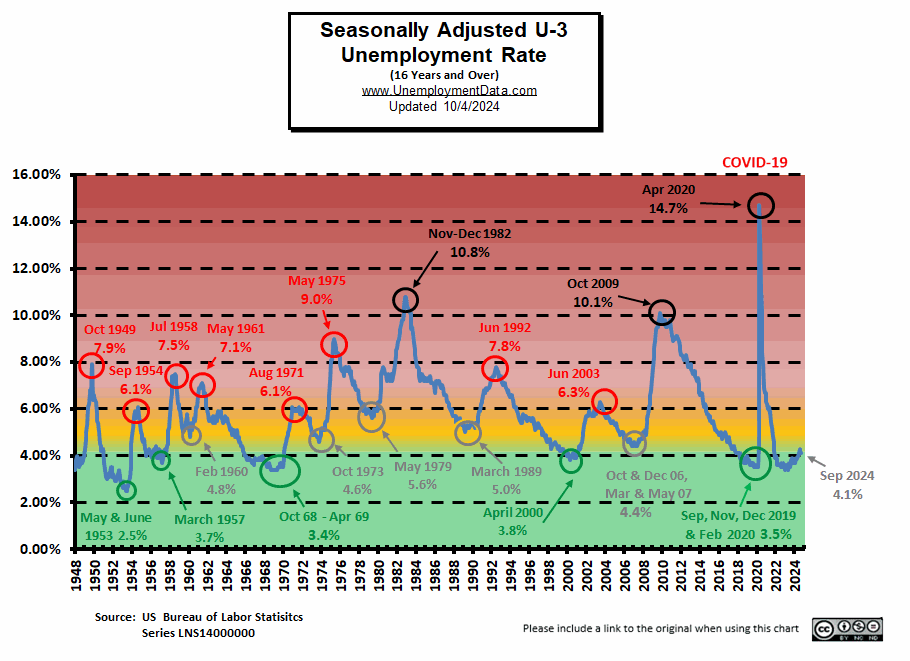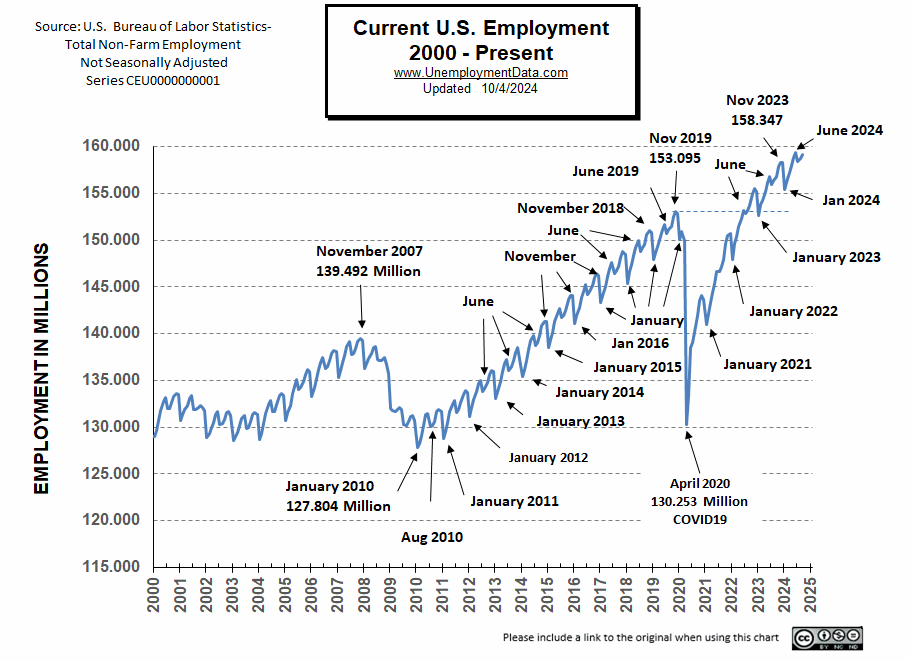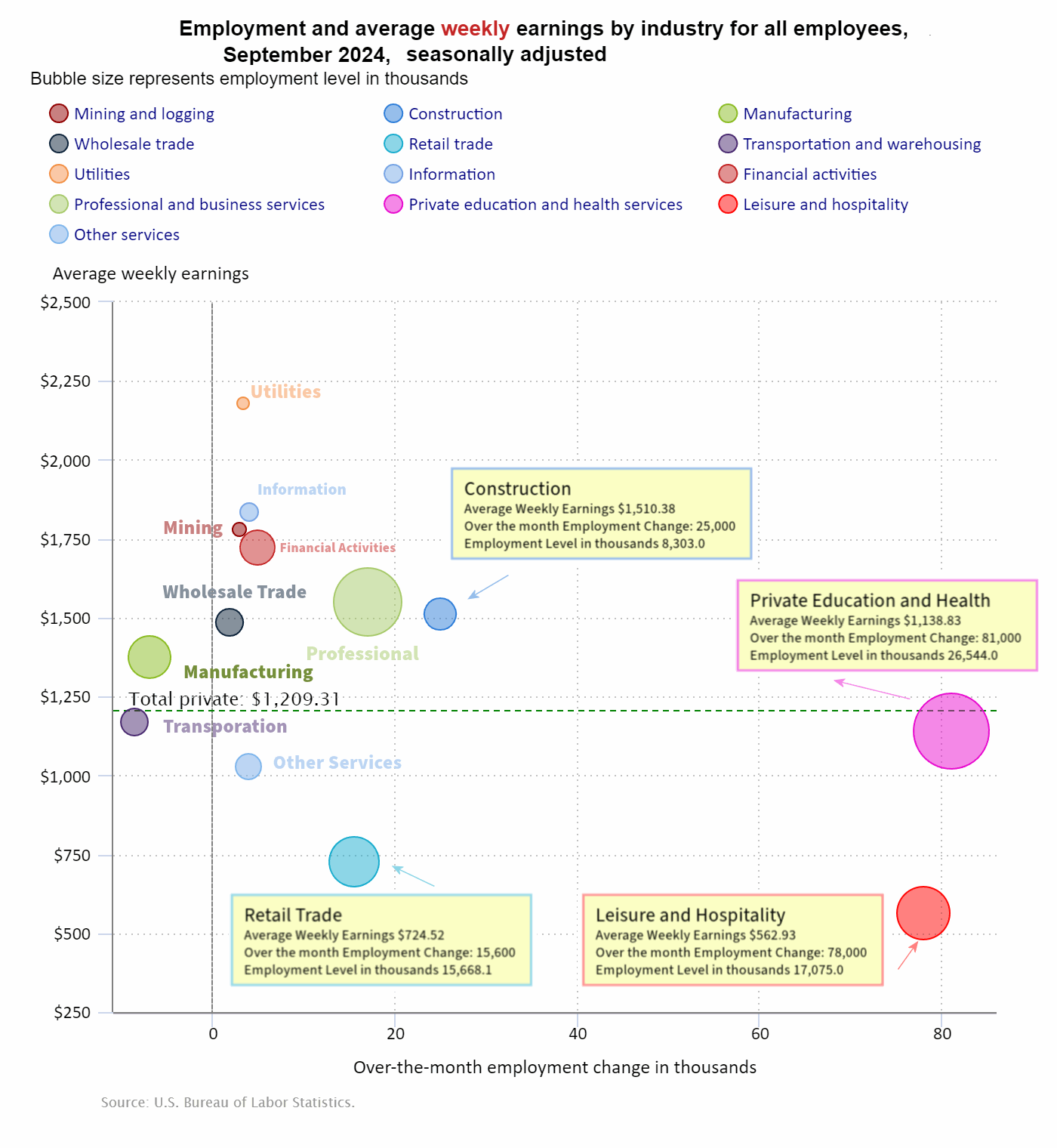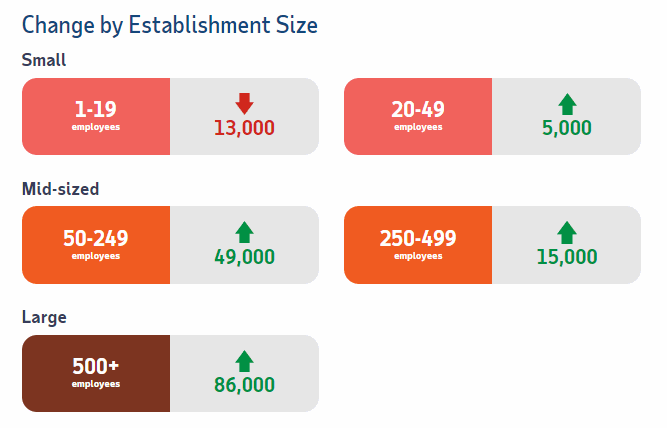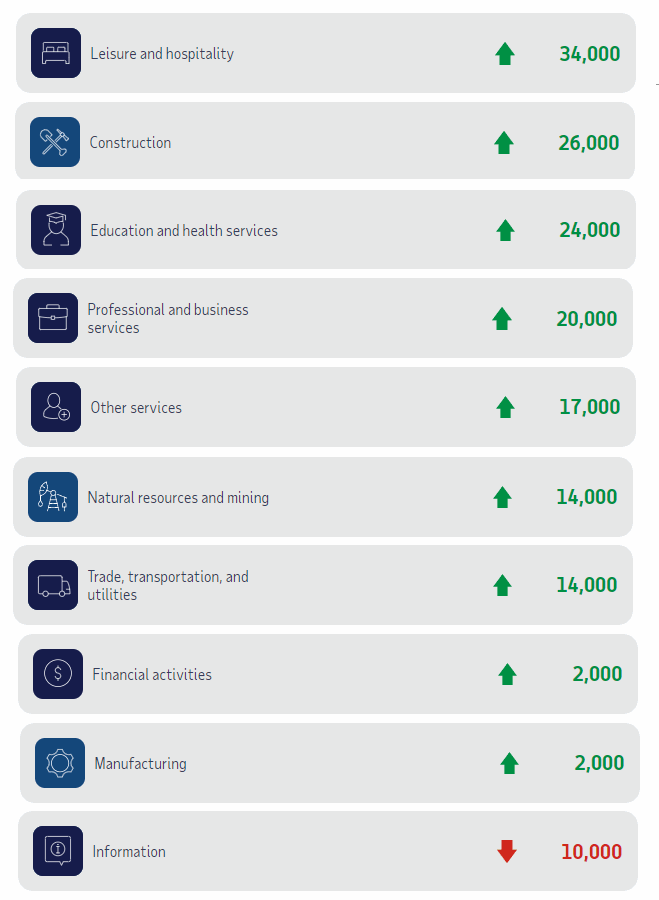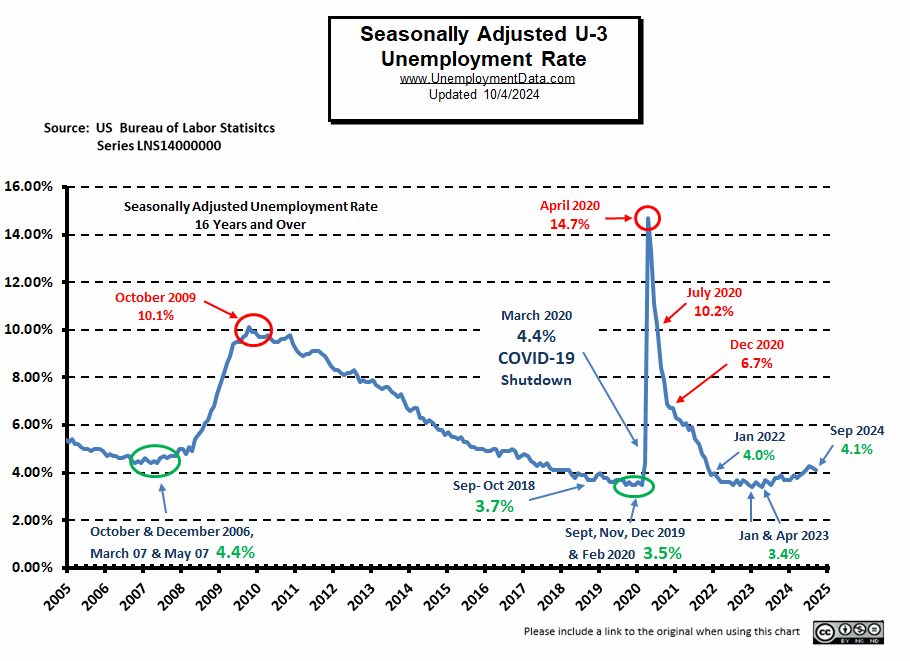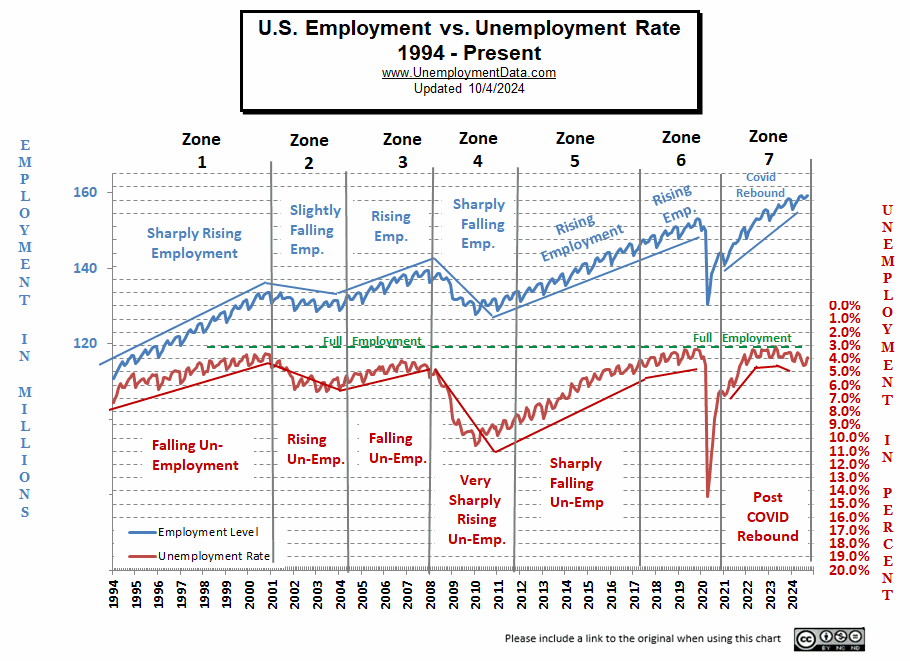The U.S. Bureau of Labor Statistics (BLS) released its employment / unemployment report for September on October 4th, 2024.
Employment / Unemployment
- Seasonally Adjusted U3- 4.1% down from 4.2% in August
- Unadjusted U3- 3.9% down from 4.4%
- Unadjusted U6- 7.3% down from 8.0%
- Labor Force Participation Rate 62.7% unchanged
- Employment 159.177 million up from 158.717 million
- Next data release November 1st, 2024
Summary:
Total Employed increased in September, Adjusted and Unadjusted Unemployment were both down.
According to the Commissioner of the U.S. Bureau of Labor Statistics:
“Total nonfarm payroll employment increased by 254,000 in September, and the unemployment rate changed little at 4.1 percent, the U.S. Bureau of Labor Statistics reported today. Employment continued to trend up in food services and drinking places, health care, government, social assistance, and construction…
Both the unemployment rate, at 4.1 percent, and the number of unemployed people, at 6.8 million, changed little in September. These measures are higher than a year earlier, when the jobless rate was 3.8 percent, and the number of unemployed people was 6.3 million. “
You can read the full BLS report here.
As usual, they are talking about “Seasonally Adjusted Jobs”.
Looking at the Unadjusted Establishment Survey report we see…
Originally the BLS reported employment of 158.650 million for August
which they adjusted slightly to 158.717 million in September.
They are currently reporting 159.177 million jobs for September which is actually an increase of 527,000 jobs based on their original numbers or 46,000 based on their new numbers. The LFPR was unchanged at 62.7%.
Good News for the Market?
The stock market responded slightly favorably with the NYSE up 0.78%. But the market doesn’t like uncertainty so it is waiting for election results before making any major moves. Other uncertainty revolves around the Middle-East and Russia.
Current Unemployment Rate Chart
Seasonally Adjusted U3 Unemployment remains well above the pre-COVID 2019 cyclical lows of 3.5%, and is approaching the yellow zone.
Current Employment Rate
The BLS originally reported employment for August as 158.650 million which they adjusted to 158.717 million. Currently they are reporting 159.177 million for September.
Employment is still 2,332,000 Above Year-Ago Levels but still -164,000 below June 2024’s peak.
See Current Employment for more information.
BLS: September 2024 Employment by Sector
The BLS employment “bubble chart” based on the Establishment Survey Data gives us a good picture of the Seasonally adjusted employment numbers.
The Bubble’s Size tells us the total Employment for that industry (i.e., larger bubbles mean more people are employed in that sector).
The bubble’s location on the chart tells us that there has been a change in Employment Levels over the most recent month… A bubble further to the right indicates larger job growth. A bubble’s vertical location on the chart shows the average industry salary.
Remember, these are Seasonally Adjusted Numbers, so they aren’t cumulative!
Looking at the above chart we can see two sectors were below zero (i.e., Transportation and Manufacturing).
With Schools back in session, Education and Health added 81,000 jobs in September. Leisure and Hospitality Services added 78,000 jobs and Construction added 25,000 jobs. Wages rose after falling in July.
BLS Average Weekly Wages
| Date | Average Weekly Wage |
| September 2024 | $1,209.31 |
| August 2024 | $1,207.70 |
| July 2024 | $1,199.39 |
| June 2024 | $1,200.50 |
| May 2024 | $1,197.41 |
| April 2024 | $1,191.93 |
| March 2024 | $1,193.34 |
| February 2024 | $1,185.75 |
| January 2024 | $1,178.16 |
| December 2023 | $1,175.46 |
| November 2023 | $1,173.04 |
| October 2023 | $1,166.20 |
| September 2023 | $1,165.47 |
| August 2023 | $1,163.41 |
| July 2023 | $1,157.28 |
| June 2023 | $1,155.15 |
| May 2023 | $1,146.99 |
| April 2023 | $1,147.58 |
| March 2023 | $1,141.34 |
| February 2023 | $1,141.61 |
| January 2023 | $1,146.14 |
| December 2022 | $1,125.73 |
| November 2022 | $1,129.01 |
| October 2022 | $1,124.01 |
| September 2022 | $1,119.87 |
| August 2022 | $1,116.42 |
| July 2022 | $1,116.54 |
| June 2022 | $1,106.76 |
| May 2022 | $1,105.47 |
| April 2022 | $1,102.01 |
| December 2021 | $1,086.46 |
Have Wages Kept Up With Inflation?
Compared to the rhetoric we are constantly bombarded with by the media you will be surprised by the actual numbers!
BLS Employment and Average Weekly Earnings by Industry
September 2024, Seasonally Adjusted Employment
Note that due to “seasonal adjusting,” although they may claim that there was a “monthly increase” (or decrease), there isn’t always an actual increase; you can’t just subtract last month’s “employment level” from this month’s level. For instance, Mining employment was supposed to have been up 3,000 in September. But August had 635,000 and September had 639,000 which looks like a 4,000 job increase. And Manufacturing looks more like a -10,000 decrease than the reported -7,000.
| Industry | Monthly Increase | September Ave. Weekly Earnings | September Employment Level | August Employment Level |
| Total Private Employment | 223,000 | $1,209.31 | 135,684,000 | 135,440,000 |
| Mining and Logging | 3,000 | $1,778.22 | 639,000 | 635,000 |
| Construction | 25,000 | $1,510.38 | 8,303,000 | 8,280,000 |
| Manufacturing | -7,000 | $1,376.80 | 12,917,000 | 12,927,000 |
| Wholesale trade | 1,900 | $1,482.94 | 6,177,500 | 6,182,000 |
| Retail trade | 15,600 | $724.52 | 15,668,100 | 15,650,400 |
| Transportation and Warehousing | -8,600 | $1,169.59 | 6,603,900 | 6,624,400 |
| Utilities | 3,400 | $2,178.51 | 594,200 | 589,700 |
| Information | 4,000 | $1,836.22 | 2,996,000 | 2,993,000 |
| Financial Activities | 5,000 | $1,722.75 | 9,259,000 | 9,258,000 |
| Professional and Business Services | 17,000 | $1,550.45 | 22,544,000 | 22,975,000 |
| Private Education and Health Services | 81,000 | $1,138.83 | 26,544,000 | 26,438,000 |
| Leisure and Hospitality | 78,000 | $562.93 | 17,075,000 | 16,976,000 |
| Other Services | 4,000 | $1,025.85 | 5,918,000 | 5,911,000 |
Source: BLS
ADP® National Employment Report
ADP provides an independent (non-government) estimate of private-sector employment and pay, based on data derived from ADP client payrolls. According to ADP®, In collaboration with Stanford Digital Economy Lab.
ADP: Private employers added 143,000 jobs in September
(This was less than June’s 150,000 but more than July’s 99,000)
- Job creation showed a widespread rebound after a five-month slowdown. Only one sector, information, lost jobs. Manufacturing added jobs for the first time since April.
Source: ADP®
ADP Private Employment by Establishment Size
As we can see from the graphic below most establishment sizes had positive gains. Those establishments with less than 20 employees were the only sector that declined slightly.
September ADP Changes:
 ADP Job Gainers / Losers
ADP Job Gainers / Losers
ADP provides an entirely different picture of the job situation compared to the BLS perspective. For instance, while the ADP says Leisure gained 34,000 jobs, BLS says they gained 78,000 jobs. And ADP says Manufacturing gained 2,000 jobs while BLS says they lost -7,000 jobs.
Unemployment
Seasonally Adjusted Unemployment is down from 4.2% to 4.1%.
Labor Force Participation Rate
The LFPR is unchanged at 62.7%.
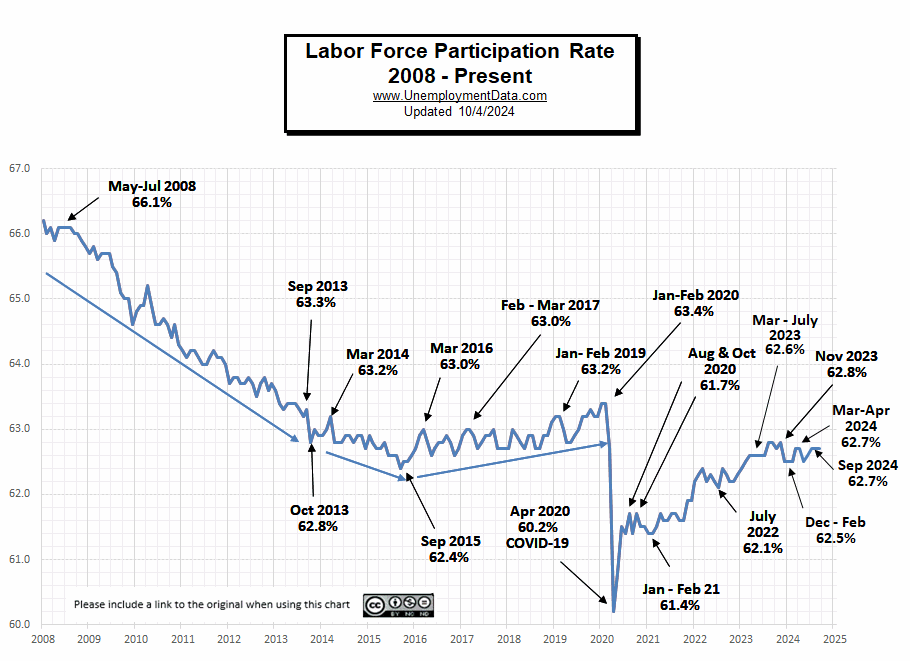
Less Than Full Employment
This chart compares employment levels with the (inverted) unemployment rate.
Full Employment is when everyone who wants a job has one. It is generally considered to be around 3%. After the unemployment rate almost touched the magic full employment line in April 2023, it began moving away (i.e., higher unemployment).
Note: The Unemployment rate is inverted to track the employment rate. Neither is Seasonally Adjusted. For more information see Employment vs. Unemployment.
Note: Full employment is not considered to be at zero percent because even when employers are having difficulty finding employees, some people are still unemployed due to either:
- structural unemployment (mismatch between worker skills and job requirements, i.e., not enough training) or
- frictional unemployment There will always be people who have quit or have lost a seasonal job and are in the process of getting a new job. Or
- Simply because they quit their job knowing it would be easy to find another (hopefully better) job.
Seasonally Adjusted U1 through U6 Unemployment Rates
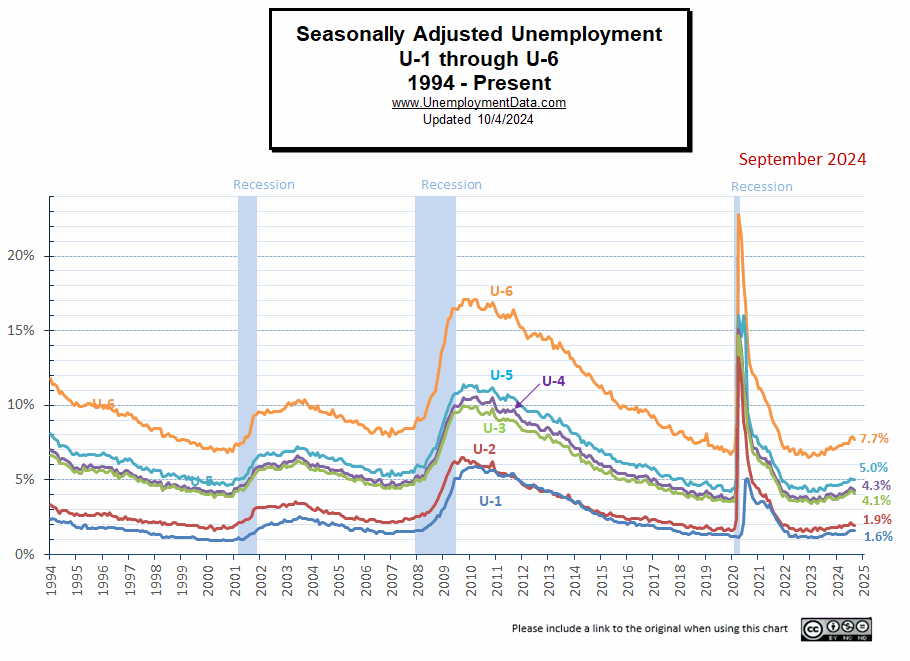
Seasonally Adjusted Unemployment by Education
This chart does refute the idea that getting a college education doesn’t help you find a job. Those with some college have half the unemployment level than someone without a High School diploma. But it doesn’t show whether they are “underemployed” i.e. working as a Barista at Starbucks or flipping burgers at McDonalds. And these numbers only apply to people over the age of 25 (so they have had some time to settle in).
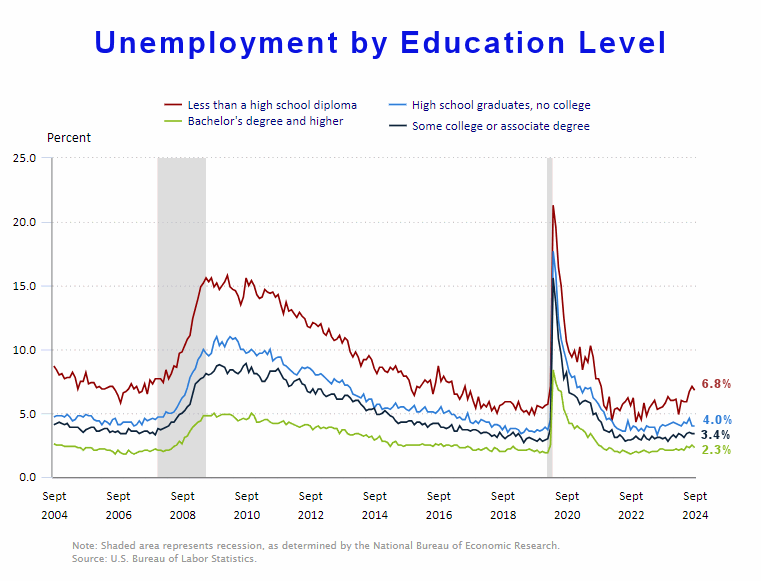
Employment-Population Ratio
This charts shows the Employment-Population Ratio with a total of 60.2% of the population working. It also shows the breakdown by gender. Men make up a much larger portion of the workforce, i.e., 67.8% of men are employed and only 56.8% of women are employed. But…
As you can see 20 years ago, back in 2004, almost 72% of men were working and 57.3% of women were working. In 2008 the Great Recession caused a massive decline in employment for both men and women. By December of 2009, only 66.4% of men were working and 55.4% of women. Over the next decade, women workers rebounded to 57.5% but men only rebounded to 69.3%.
Now less than 68% of men are working and 56.8% of women are working, so it isn’t women who have left the workforce but men. Perhaps there are more stay-at-home Dads because their wives could earn more? Or more men decided to retire in 2009 and 2020, rather than bother returning to the workforce.
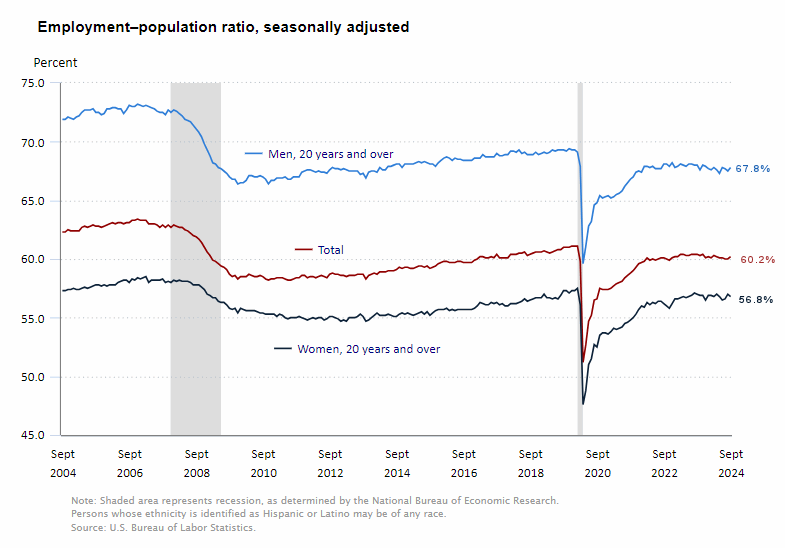
- Have Wages Kept Up With Inflation?
- August 2024 Jobs Report
- BLS Erases 800,000 Jobs
- July Jobs Report Spooks Stock Market
- Opportunities You Can Find With a CDL License
- Why Consumer Sentiment Fell To A Seven-Month Low
From InflationData.com
- FED Interest Rates
- Gold Rallies on LOWER August Inflation?
- Optimize Your Finances as Inflation Cools
- What Causes Stagflation?
- Inflation Causes Inequality
- Inflation’s Hidden Impact on Healthcare: What’s Driving Costs Up?
- The Death of the PetroDollar
From Financial Trend Forecaster
- NYSE ROC
- NASDAQ ROC
- Crypto ROC – BTC and ETH
- China’s Monetary Bazooka
- How Much is the Money Supply Growing?
- Is Gold Overpriced?
- Are Some Forms of Taxation Worse Than Others for the Economy?
- Are Price Controls a Good Idea?
- Modern Monetary Theory (MMT)
- Canada’s Economic Crisis
- Crypto: Crash or Opportunity?
- Bureaucracy: The Red Tape that Prevents Economic Growth
- How Washington and the Fed Caused the Commercial Real Estate Crisis
- Invest Like Warren Buffet
- Gold Prices: The calm before a record run
- This Trend Will Likely Soon Rock the U.S. Financial System
- Elliott Wave Analysis of Bitcoin
- Is a China-Taiwan Conflict Likely? Watch the Region’s Stock Market Indexes
From OptioMoney
- Consumer Culture Contrasting Spending Habits in the US and Europe
- Financial Considerations When Moving to Florida
- Splitting Your Golden Years:
- Home-Buying Guide for Newlyweds
- Smart Ways to Save for a Rainy Day Fund
From Your Family Finances

